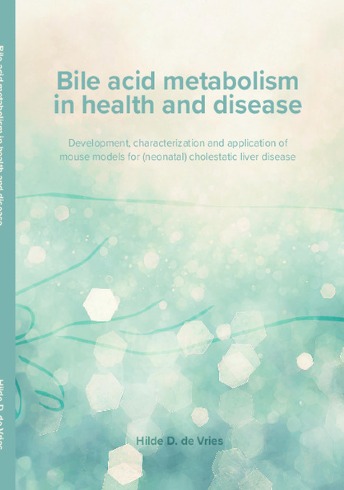Save the Date: PhD Defence Hilde de Vries

On June 27th, PhD candidate Hilde de Vries will be defending her PhD thesis Bile acid metabolism in health and disease. Development, characterization and application of mouse models for (neonatal) cholestatic liver disease.
The ceremony consists only of the official defense; there is no layman's talk.
NB: The defence will also be broadcast through a livestream.
|
14:00 - 15:00
|
Public defense
|
Cholestasis, characterized by accumulation of bile acids (BAs) in the liver, leads to liver pathology. Pre-clinical research into BA metabolism is often performed in mouse models. However, mice possess murine-specific BAs, i.e. muricholic acids (MCAs), with distinct signaling properties, that are not present in humans. In this thesis, Hilde de Vries describes the generation and characterization of Cyp2c70-deficient mice, that lack MCAs and display a BA composition comparable to humans. CYP2C70 was responsible for both 6β-hydroxylation of chenodeoxycholic acid (CDCA) as well as epimerization of the C7 hydroxyl group in α-MCA and CDCA. Cyp2c70-deficient mice displayed features of cholestasis at the age of 3-weeks old. Elevated plasma BA concentrations in Cyp2c70-deficient pups coincided with altered gene expression in their hearts and whitening of brown adipose tissue. Perinatal ursodeoxycholic acid (UDCA) treatment prevented features of cholestasis and normalized cardiac gene expression in these mice. Especially female Cyp2c70-deficient mice developed cholangiopathy progressing with age, which could be reversed by UDCA treatment. Cyp2c70-deficient mice without functional farnesoid x receptor (FXR) did not develop severe liver disease, while humans with FXR-deficiency do. By using human plasma samples from Lifelines cohorts, it was found that the relative abundance of individual BA species in maternal blood correlate with those in the fetus, but not with lipid levels in the fetus. Sulfated BAs were abundantly present in healthy humans and their proportions were associated with lipidomic traits.
This thesis highlights various aspects of BA metabolism in mice and humans, in health and disease, in newborns and adults.
Dissertation: https://hdl.handle.net/(...)99-80ed-bdb02a7e73f7
